I've done it! Have you?
Well, not quite, there's a few more days to go, but I'm hopeful I'm going to make it. So, what's next - and did I cheat?
Welcome to all the new subscribers to Rule of 5. If you are interested in following this campaign, we provide tips, tactics, resources, ideas and lots of moral support to help get you through the year. Inspiration this year came from swapping, altering, mending, renting and borrowing - I have more plans for next year, so follow along! I promise a rewarding ride.
At the beginning of this year, some of us made a promise. We promised we would only buy five new fashion items for the next 12 months because that’s all the climate scientists are telling us we can afford. Many of you have joined this campaign, including Topshop and Whistles hero Jane Shepherdson, Emily Chan, the sustainability editor of Vogue, Fanny Moizant, founder of Vestiaire Collective and Lauren Indvik, fashion editor of the Financial Times. If you love fashion, it seemed like a good way for us to maintain our relationship with clothes whilst moving more responsibly through the world.
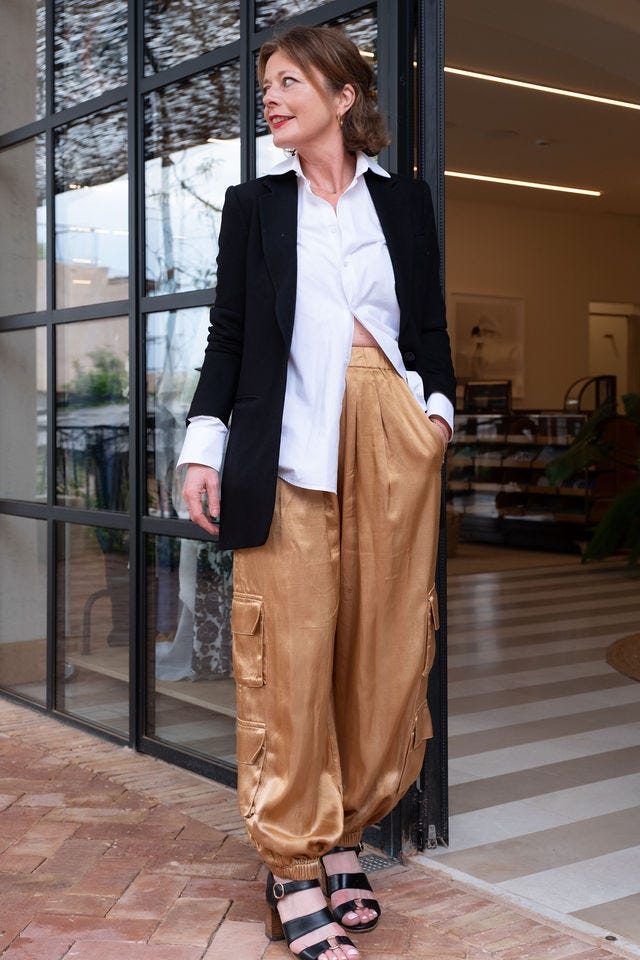
Supportively, all my friends said I couldn’t do it. A dyed in the wool fashion editor, who now even co-runs her own fashion store, how could I possibly pull this off?
Ha! Thanks everyone. Well here we are - December - and I think I’ve done it. For those who nearly did it, that is just as good, and there’s always next year (more on this below).
This is about taking matters into our own hands, a collective journey into more conscious consumerism and taking back the power of where we as a society, individuals and a planet. It’s not been an easy journey, but it has been incredibly rewarding. Here’s how.
If you would like to join the Rule of 5 campaign, please do subscribe, as there are regular helpful bulletins. Also, it’s easier - and more fun - if you do it with a friend - this post is public so feel free to share it.
What I bought - and what I didn’t buy
It all started so well, a wardrobe audit in January revealed the cornerstone piece I was missing - a white shirt. I spent weeks researching, tried dozens on, and then landed on The One. A boyfriend cut poplin number, made from organic cotton. Better, it is from a small independent local brand, With Nothing Underneath. Tick tick tick. Easy!
Then came shopping paralysis. having vowed to cut back I had to turn down all new season treats. No floral midi dress, no high waisted corduroy trouser, no Spring 23 ballet flat. Suddenly, I couldn’t buy anything - nothing seemed important enough to merit a ‘serious purchase’.
Then - disaster struck. I wondered into AGORA, the luxury and sustainability store I co-run in Ibiza, picked a pair of gold silk cargo pants off the rail, tried them on and - never took them off. Total Impulse buy, totally frivolous purchase. But I did learn something - fashion is sometimes about that, sheer fun, and that doesn’t have to be denied. I just had to learn to not do it again.
The summer was hard: I went away and packed badly, my daughter lost my shoes, I was bored of all my clothes. Purchase number three were useless (biodegradable) rubber and jute black sandals I was forced into buying and which will not last the year (biodegradable: sustainable in some ways, but not in others). This campaign was NO FUN. I came back in September and revenge shopped with Vestiaire Collective, buying a Gabriela Hearst shirt (which arrived with a missing button and a thread pull) and a sensible Toteme polo knit I could layer under everything. A win and a lose.
My spirit was lifted by commissioning a long desired treat: a bespoke embroidered house coat from Alice Temperley. All that money I saved by not ‘popping into Zara’ found a much better avenue. Alice is Queen of the House Coat, and having something specially made is a once in a lifetime treat. Embroiderers are busy sewing now, I am very excited for its arrival.
How fashion tricks us
The truth is, if fashion (and the world) wants to hit the 2030 1.5C warming target, no amount of regenerative materials, biotechnology or recycled polyester is going to get us there: we just have to stop consuming so much. You can see it in the satellite pictures of the Atacama desert, you can see it in the overflowing landfills of west Africa, you can see it in the piles of dirty clothes left on the pavements outside high street charity stores. The world is choking on clothes.

Do we really need to buy this much stuff, or are we just falling victim to the powerful marketing campaigns fashion deploys, telling us we must keep up, we must stay relevant, we must be on trend? This is what the Rule of 5 set out to find out. Do we really need a constantly replenished sneaker wardrobe, a suite of white shirts, a biannual bikini overhaul, another perfect day dress, or a new velvet suit? (Well - it is Christmas after all.)
Or is our over consumption conditioned by an advertising industry telling us that our very meaning is dependent on these possessions? The best piece of insight I got this year was the two week cool off period. When I really wanted something, I left it for two weeks. If I still wanted it - then it was probably worth buying. I hardly ever ‘still wanted it’.
Listening to a podcast with Kate Raworth recently, (she of Doughnut Economics), I was turned on to the work of Edward Bernays, nephew of Sigmund Freud and the so called ‘father of public relations’. An advertising mastermind, one of his most successful campaigns was telling women that if they smoked they would become empowered and even fall in love, (he dubbed cigarettes “torches of freedom”).
In 1928 Bernays wrote the seminal book, Propaganda, in which he noted:
The conscious and intelligent manipulation of the organized habits of the masses is an important element in democratic society. Those who manipulate this unseen mechanism of society constitute an invisible government which is the true ruling power of our country. We are governed, our minds are moulded, our tastes formed, and our ideas suggested, largely by men we have never heard of…. It is they who pull the wires that control the public mind.
Sinister stuff. Drawing on his Uncle’s psychoanalytical observations, he called public relations “the engineering of consent” and identified that this ‘consent’ could be manipulated by appealing to the unconscious rather than the rational part of the mind. That an idea or even an object could be framed as leading to satisfaction and purpose - happiness even. He worked for politicians (his work inspired Joseph Goebbels to create a cult around Hitler), and he monetised his theory by working for consumer companies like Proctor & Gamble, Dixie Cups and General Electric. Essentially, he manipulated audiences into thinking they needed stuff they did not want.
Sound familiar? It’s the basis of consumer culture, and 100 years later we now find ourselves choking on our own stuff and experiencing unprecedented levels of mental health issues. Turns out cigarettes do not empower you, nor do face creams make you happy, or televisions give you purpose.
We’re not going to change anything unless we make it fun
Fashion is wonderful fun, but our relationship with it is twisted. Dialling back my shopping this year has taught me that. That my progress, my endorphin releases, my rewards and my relevance have been to a large part defined by fashion. Keeping up with trends is entertaining, but in a world where we now cycle through 10 trends a day, keeping up is just not possible - so why bother? Developing a personal style is a lot more sophisticated.
Secondly, newness can arrive in different forms - rental, alteration, swapping and borrowing all tick that box in a very satisfactory manner, it turns out. Please check out the rest of this Substack for details, I’ve tried them all.
Progress has been a hard one. I have had to look to other places to mark the beginning of a new season, a graduation at work or in life. Nothing semaphored ‘the new’ to me like new season Prada. This year I had to find it internally from books and films, and externally through conversation and ideas.
But fun? I’ve had more fun with fashion this year than ever before. It turns out dialling down ‘buying new’ forces you to be more creative. Shopping my own wardrobe, I discovered I had way more than I realised (we actually only ever wear about 30% of our wardrobe, according to WRAP). With a good seamstress and some styling ideas on hand, there’s plenty of treasures in there yet to discover.
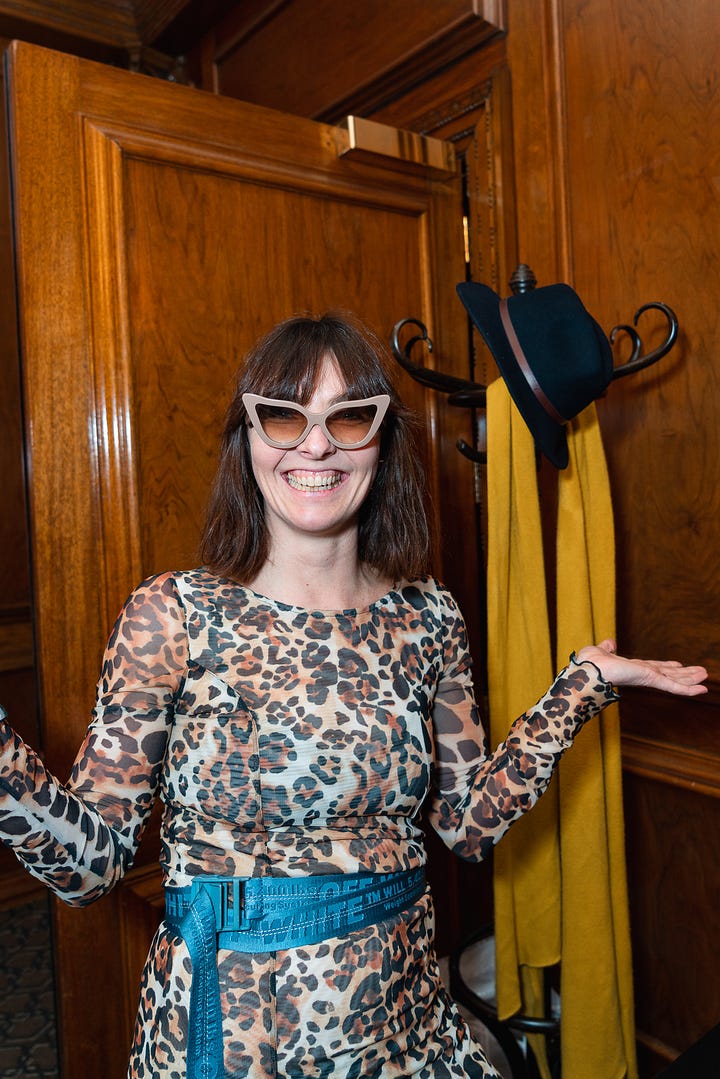
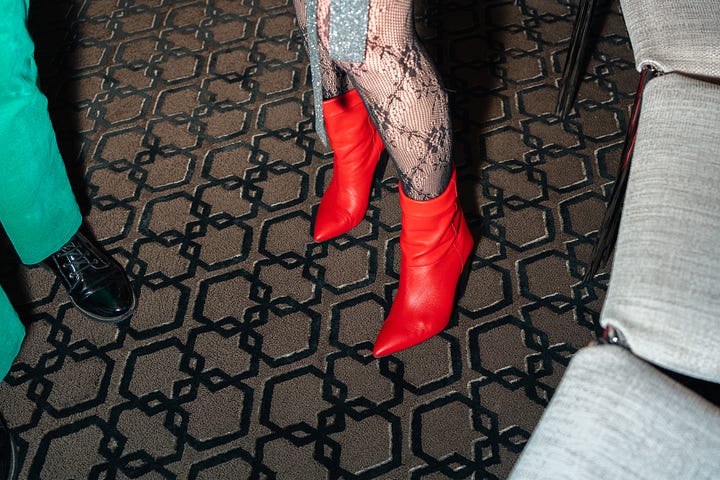
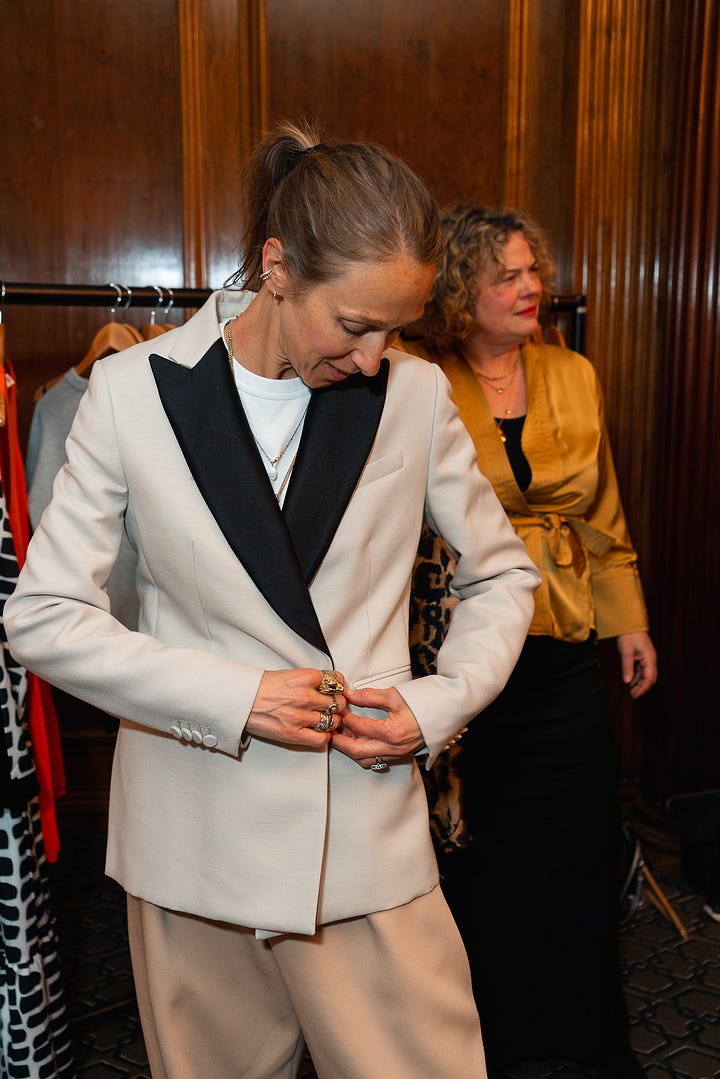
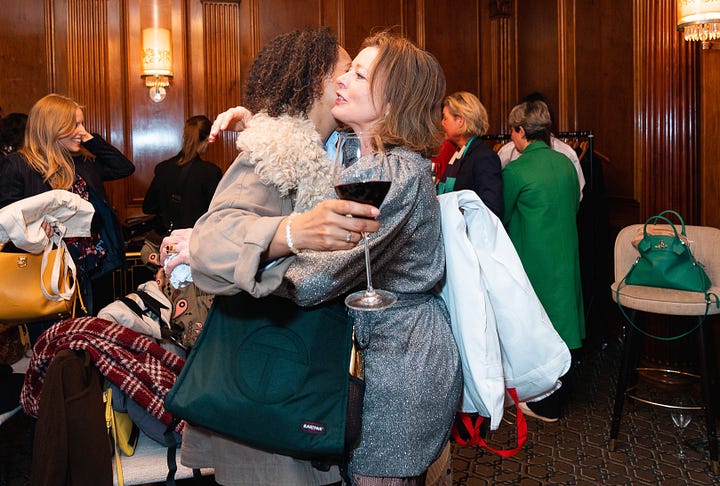
It’s not about denial
After all, this isn’t about denial - what I love about this campaign is we are not giving up on fashion at all. With five new things spread out over the year we would still have the opportunity to shop, and by really thinking hard about our purchases, making sure they really count, and then treasuring them when they arrive, shopping has actually become a lot more fulfilling.
I’ve made mistakes, but I’ve learned from them. The shirt, the gold trousers (which actually turned out to be very useful), the brown polo knit and the house coat when it comes, have much mileage for the future. The shoes - not so much. (Thinking my first January purchase may be a pair of second hand black leather sandals. N one buys sandals in January, so I may score a hit). Either way, the thrill of the hunt is on.
The big question is - shall we stick to five again next year? Personally, I don’t think I can ever go back. I could not walk through the doors of Zara and sweep garments off hangers without being ill. I have no intention of resubscribing to those Net-a-Porter emails that trigger my shopping anxiety.
But I don’t think 5 is quite right. Emily Chan at Vogue says small things like socks and hats don’t count (I don’t know about that - I think the Atacama desert has a few of those), but I really needed a sun hat when I went abroad and cashed in a second hand token to buy that: a few measured second hand purchases are helpful. Lauren at the Financial Times allowed herself 4, which I think is about right.
The problem is clothing attrition: I left a beanie hat on a train in the middle of a cold snap, my daughter left my flip flops on the beach, my white t-shirt (two years old) is now grey. These are three essential replacement purchases already. I’ve also had terrible trouble with moths in the last few months and many of my sweaters have been eaten up, but I’m just going to get them darned, (hello Save Your Wardrobe).
Finally - the question all my friends asked: did I cheat? (I’m not sure what this says about my friends, or me for that matter). In the spirit of transparency, I did make a couple of mistakes. I went swimming with a girlfriend outdoors in England in early March and she leant me a woolly hat I ended up taking home. I didn’t think twice about it at the time, then realised that actually this was theoretically a fashion gift (and gifts count). Perhaps it was the universe confiscating my beanie hat on the train later in the year.
And I also bought a halter neck swimsuit as a piece of underwear to wear underneath an evening gown I rented for a party. Lingerie is allowed (but don’t go mad), so I reasoned this is ok. But technically this was a Kymina swimsuit, not a silk slip and I have actually worn it swimming since.
Will you forgive me?
I vow to go again next year. Please come along with me for the ride - we can share tips and tricks, successes and failures. I promise you: it is fun.
Rule of 5 is a campaign to encourage more conscious shopping - and more fun with fashion. Please join us by subscribing below. Of course it’s free to follow - we’re saving the world! - but if you pay, that’s commitment.
See you in 2024, let’s do this!
Tiff
Also, if you are interested in more sustainable fashion stories, I run another Substack, It’s Not Sustainable. You can check it out here, or subscribe below
And I’m dying to hear from you! Please leave a comment if you did this campaign, even if it was just aprt way through the year. Or if you are thinking about doing it next year - say hello!




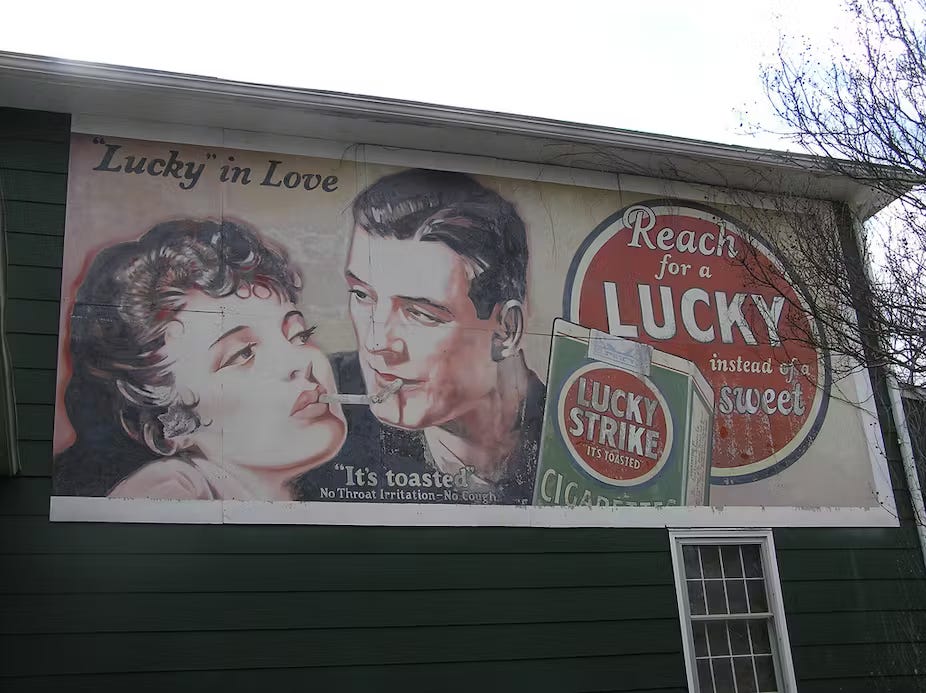
Love this! I had made my New Years Resolution for next year not to buy any new clothes, only second hand, but reading about the Rule of Five, maybe this is better! Am excited to keep following the campaign.
I tried and totally failed--bought 25 pieces (new and secondhand). I wasn’t happy with my clothes as quite a few things didn’t fit anymore so I think I did the right thing to shop for my body’s needs and it’s made me more satisfied with what I have.
I did learn a lot from the attempt and will be trying again in 2024! This time I’ve actually made a plan--
1 winter item, probably a jumper;
1 basic item in case I need to replace something that’s a necessity (eg if I lose my sun hat);
1 spontaneous but considered item because there’ll always be a place in my life for something beautiful
1 non-basic essential (I would really like a new button down shirt and hope to find the right piece)
1 “open” item in case I need one more of any of the items above.
Some of these items overlap, which would be great. Also, my goal is to shop secondhand first, and in person where possible.
I also plan have a few no-buy months scattered throughout the year just to detox from the need for a dopamine hit from shopping. I’m thinking Feb, April, June, September, November and December.